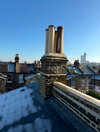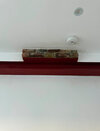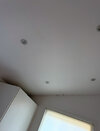If you’ve lined the chimneys, then you are using it to transfer heat up the chimney which does the same thing as ventilation.Thanks yes looks like that's it.
But... so why do lined chimneys blocked with register plates at bottom not need air bricks?
You are using an out of date browser. It may not display this or other websites correctly.
You should upgrade or use an alternative browser.
You should upgrade or use an alternative browser.
Do I have to ventilate a capped chimney, isn't it just like a cavity wall?
- Thread starter ChrisKingston
- Start date
Within the flue, but what about the void around the flue inside the chimney?If you’ve lined the chimneys, then you are using it to transfer heat up the chimney which does the same thing as ventilation.
That's what foxhole was saying, imagine it like having a long radiator pipe in the chimney spaceWithin the flue, but what about the void around the flue inside the chimney?
- Joined
- 1 May 2018
- Messages
- 2,219
- Reaction score
- 742
- Country

They really should not! (or at least internally) I am involved with installing "chimneys" often through flat roofs. (actually Pneumatic Tube stations in hospitals, which often have the tube routed out of a ward through the roof and cross to somewhere else outside). These will be 110mm and 160mm tubes. I can guarantee you that if we don't intentionally valve off the tube so it doesn't have an open end exposed to the room, we end up with a condenser. The warm humid air from the room goes in to the open end, rises and condenses in the tube as it passes to the cool outside, and runs back down.Redundant flues should be ventilated at the bottom
If the room is pressurised (e.g. manufacturing Pharmacy) we have to weight the valves to above room pressure to make sure they are closed when the system is dormant.
This is exactly the same as a chimney - an opening to a warm room which allows room air to rise to a cold area. Same problem - you get condense where the warm rising air hits the dew point.
OP,
Redundant flues should be vented at the bottom.
Redundant flues should be vented at the bottom.
Yes I will leave it ventilated! Perhaps with one of those C-caps on top of the stack to reduce the heat loss.OP,
Redundant flues should be vented at the bottom.
Thanks everyone for the advice. I guess bricks are less waterproof than I thought.
- Joined
- 1 May 2018
- Messages
- 2,219
- Reaction score
- 742
- Country

Show me the science.Redundant flues should be vented at the bottom.
OP
redundant flues should NOT be ventilated at the bottom internally.
In fact when we need to actually install a vertical ventilation pipe, we have to fit condense traps to catch the condense caused by the air passing from warm area to cold area https://nhbc-standards.co.uk/2018/8-services/8-1-internal-services/8-1-12-extract-ducts/
Last edited:
Post removed. Please read forum rules.
.
I'd not be too worried about a bit of condensation if the chimney is ventilated. Worse is to trap it in there if/when water penetrates into the chimney or the humid air permeates through from the house.Show me the science.
OP
redundant flues should NOT be ventilated at the bottom internally.
In fact when we need to actually install a vertical ventilation pipe, we have to fit condense traps to catch the condense caused by the air passing from warm area to cold area https://nhbc-standards.co.uk/2018/8-services/8-1-internal-services/8-1-12-extract-ducts/
Ventilation ducting is a bit different due to the intentional extraction of humid air and the higher flow rates.
But my highest preference is to ventilation from the outside to avoid the issue as I showed in my diagram.
- Joined
- 1 May 2018
- Messages
- 2,219
- Reaction score
- 742
- Country

Exactly!But my highest preference is to ventilation from the outside to avoid the issue as I showed in my diagram.
Hey folks, I have a somewhat similar problem, so thought I would ask for advice here.
I have a chimney stack that goes through the roof. Bits of it are visible internally. The chimney breast has been removed (see pics attached).
I previously had issues with leaks through the chimney stack, but it has been repointed and capped properly, so there are no leaks when it rains.
It’s been frosty for the past week or so and I’ve noticed new wet stains on the ceiling.
Could it be because there’s no ventilation at the bottom of the chimney stack? Or is it something else?
I have a chimney stack that goes through the roof. Bits of it are visible internally. The chimney breast has been removed (see pics attached).
I previously had issues with leaks through the chimney stack, but it has been repointed and capped properly, so there are no leaks when it rains.
It’s been frosty for the past week or so and I’ve noticed new wet stains on the ceiling.
Could it be because there’s no ventilation at the bottom of the chimney stack? Or is it something else?
Attachments
OP,
You could ask the mods to move you post to a new thread - its usually best not to piggyback old threads.
Which ceiling is showing wet stains - a pic please?
Why not show a pic of the chimney breast on the floor above the RSJ?
Do you have any other chimney breasts in the house?
Is that a shared stack?
The caps on the chimney pots are for redundant flues so you presumably dont have any active flues?
The lead flashing on the chimney stack & parapet is wrong.
Have you been into the loft & examined the chimney breast for moisture stains?
You could ask the mods to move you post to a new thread - its usually best not to piggyback old threads.
Which ceiling is showing wet stains - a pic please?
Why not show a pic of the chimney breast on the floor above the RSJ?
Do you have any other chimney breasts in the house?
Is that a shared stack?
The caps on the chimney pots are for redundant flues so you presumably dont have any active flues?
The lead flashing on the chimney stack & parapet is wrong.
Have you been into the loft & examined the chimney breast for moisture stains?
Sorry about that, moved it to a new thread — https://www.diynot.com/diy/threads/damp-issue-with-warm-roof.641202/.
DIYnot Local
Staff member
If you need to find a tradesperson to get your job done, please try our local search below, or if you are doing it yourself you can find suppliers local to you.
Select the supplier or trade you require, enter your location to begin your search.
Please select a service and enter a location to continue...
Are you a trade or supplier? You can create your listing free at DIYnot Local
Similar threads
- Replies
- 1
- Views
- 7K
- Replies
- 11
- Views
- 1K



